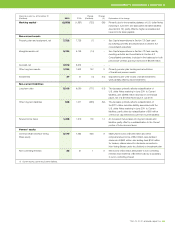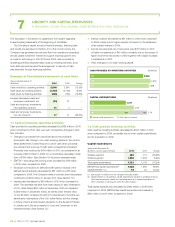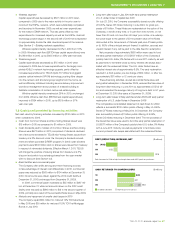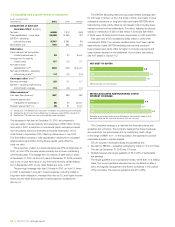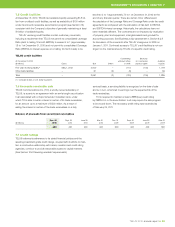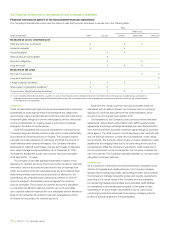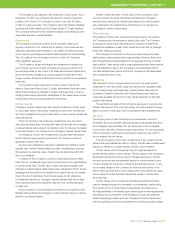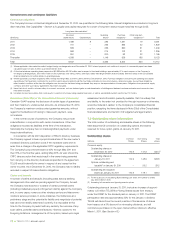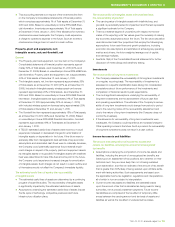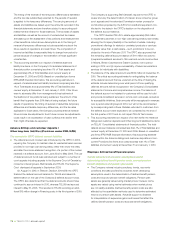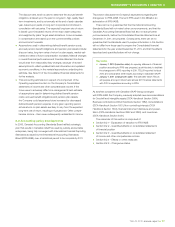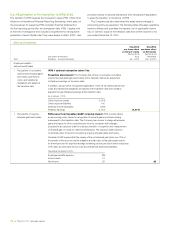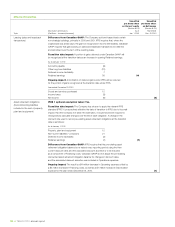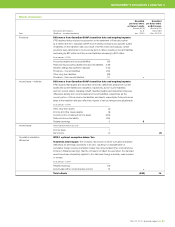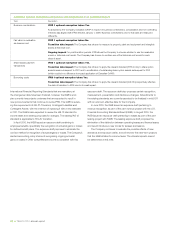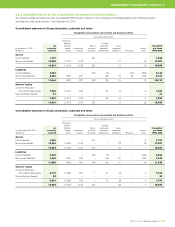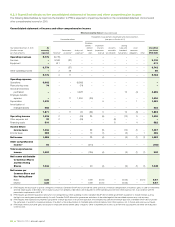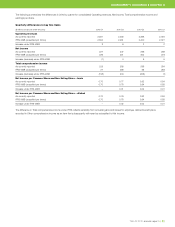Telus 2010 Annual Report Download - page 79
Download and view the complete annual report
Please find page 79 of the 2010 Telus annual report below. You can navigate through the pages in the report by either clicking on the pages listed below, or by using the keyword search tool below to find specific information within the annual report.
TELUS 2010 annual report . 75
MANAGEMENT’S DISCUSSION & ANALYSIS: 8
The recoverability of intangible assets with indefinite lives;
the recoverability of goodwill
.The carrying value of intangible assets with indefinite lives, and
goodwill, is periodically tested for impairment and this test represents
a significant estimate for the Company.
.There is a material degree of uncertainty with respect to the esti-
mates of the reporting units’ fair values given the necessity of making
key economic assumptions about the future. The fair value calculation
uses discounted cash flow projections that employ the following key
assumptions: future cash flows and growth projections, including
economic risk assumptions and estimates of achieving key operating
metrics and drivers; the future weighted average cost of capital;
and earnings multiples.
.See Note 16(d) of the Consolidated financial statements for further
discussion of methodology and sensitivity testing.
Investments
The recoverability of long-term investments
.The Company assesses the recoverability of its long-term investments
on a regular, recurring basis. The recoverability of investments is
assessed on a specific identification basis taking into consideration
expectations about future performance of the investments and
comparison of historical results to past expectations.
.The most significant assumptions underlying the recoverability of
long-term investments are the achievement of future cash flow
and operating expectations. The estimate of the Company’s recover-
ability of long-term investments could change from period to period
due to the recurring nature of the recoverability assessment and
due to the nature of long-term investments (the Company does not
control the investees).
.If the allowance for recoverability of long-term investments were
inadequate, the Company could experience an increased charge to
Other operating income in the future. Such a provision for recoverability
of long-term investments does not result in a cash outflow.
Income tax assets and liabilities
The amount and composition of income tax assets and
income tax liabilities, including the amount of unrecognized
tax benefits
.Assumptions underlying the composition of income tax assets and
liabilities, including the amount of unrecognized tax benefits, are
based upon an assessment of tax positions as to whether, on their
technical merit, they are more likely than not of being sustained
upon examination, and then an estimate of the amount of tax benefit
that is greater than 50% likely of being realized upon ultimate settle-
ment with taxing authorities. Such assessments are based upon
the applicable income tax legislation, regulations and interpretations,
all of which in turn are subject to interpretation.
.Current income tax assets and liabilities are estimated based
upon the amount of tax that is calculated as being owed to taxing
authorities, net of periodic instalment payments. Future income
tax liabilities are comprised of the tax effect of temporary differ-
ences between the carrying amount and tax basis of assets and
liabilities as well as the tax effect of undeducted tax losses.
.This accounting estimate is in respect of the Inventories line item
on the Company’s Consolidated statements of financial position,
which comprises approximately 1% of Total assets at December 31,
2010 and 2009. Based on unaudited pro forma IFRS-IASB finan-
cial information, Inventories are approximately 1% of Total assets
at December 31 and January 1, 2010. If the allowance for inventory
obsolescence were inadequate, the Company could experience
a charge to operations expense in the future. Such an inventory
obsolescence charge does not result in a cash outflow.
Property, plant and equipment, net;
Intangible assets, net; and Goodwill, net
General
.The Property, plant and equipment, net, line item on the Company’s
Consolidated statements of financial position represents approxi-
mately 39% of Total assets, as at December 31, 2010 (40% as at
December 31, 2009). Based on unaudited pro forma IFRS-IASB
finan-
cial information, Property, plant and equipment, net, is approxi
mately
40% of Total assets at December 31 and January 1, 2010.
.The Intangible assets, net, line item represents approximately 26%
of Total assets, as at December 31, 2010 (27% as at December 31,
2009). Included in Intangible assets, wireless spectrum licences
represent approximately 20% of Total assets, as at December 31,
2010 and 2009. Based on unaudited pro forma IFRS-IASB financial
information, Intangible assets are approximately 31% of Total assets
at December 31, 2010 (approximately 32% at January 1, 2010),
with included wireless spectrum licences being approximately 25%
of Total assets at December 31 and January 1, 2010.
.The Goodwill line item represents approximately 18% of Total assets,
as at December 31, 2010 (19% as at December 31, 2009). Based
on unaudited pro forma IFRS-IASB financial information, Goodwill
represents approximately 18% of Total assets at December 31
and January 1, 2010.
.If TELUS’ estimated useful lives of assets were incorrect, it could
experience increased or decreased charges for amortization of
intangible assets or depreciation in the future. If the future were to
adversely differ from management’s best estimate of key economic
assumptions and associated cash flows were to materially decrease,
the Company could potentially experience future material impair-
ment charges in respect of its property, plant and equipment assets,
its intangible assets or its goodwill. If intangible assets with indefinite
lives were determined to have finite lives at some point in the future,
the Company could experience increased charges for amortization
of intangible assets. Such charges do not result in a cash outflow and
of themselves would not affect the Company’s immediate liquidity.
The estimated useful lives of assets; the recoverability
of tangible assets
.The estimated useful lives of assets are determined by a continuing
program of asset life studies. The recoverability of tangible assets
is significantly impacted by the estimated useful lives of assets.
.Assumptions underlying the estimated useful lives of assets include
the life cycle of technology, competitive pressures and future
infrastructure utilization plans.


